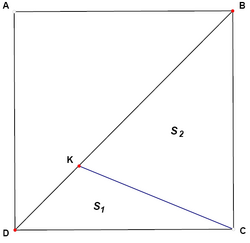Difference between revisions of "2007 Cyprus MO/Lyceum/Problem 14"
(img) |
I_like_pie (talk | contribs) (Added Solution) |
||
| Line 8: | Line 8: | ||
==Solution== | ==Solution== | ||
| − | {{ | + | <math>\triangle KBC</math> and <math>\triangle KCD</math> have the same heights (<math>\perp BD</math>), so the ratio of their areas is simply the ratio of <math>KD:KB</math>. |
| + | |||
| + | Let <math>KB=x</math>. Then <math>KD=x\sqrt{2}-x</math>, and the ratio of <math>S_1:S_2</math> is <math>x\sqrt{2}-x:x</math>, or <math>\sqrt{2}-1:1\Longrightarrow\mathrm{ D}</math>. | ||
==See also== | ==See also== | ||
{{CYMO box|year=2007|l=Lyceum|num-b=13|num-a=15}} | {{CYMO box|year=2007|l=Lyceum|num-b=13|num-a=15}} | ||
Revision as of 23:02, 8 May 2007
Problem
In square ![]() the segment
the segment ![]() equals a side of the square. The ratio of areas
equals a side of the square. The ratio of areas ![]() is
is
![]()
Solution
![]() and
and ![]() have the same heights (
have the same heights (![]() ), so the ratio of their areas is simply the ratio of
), so the ratio of their areas is simply the ratio of ![]() .
.
Let ![]() . Then
. Then ![]() , and the ratio of
, and the ratio of ![]() is
is ![]() , or
, or ![]() .
.
See also
| 2007 Cyprus MO, Lyceum (Problems) | ||
| Preceded by Problem 13 |
Followed by Problem 15 | |
| 1 • 2 • 3 • 4 • 5 • 6 • 7 • 8 • 9 • 10 • 11 • 12 • 13 • 14 • 15 • 16 • 17 • 18 • 19 • 20 • 21 • 22 • 23 • 24 • 25 • 26 • 27 • 28 • 29 • 30 | ||










